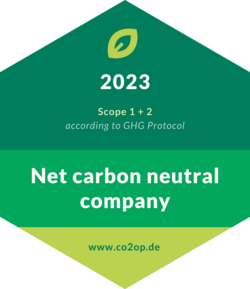OUR SERVICES
We help your company reduce its
corporate carbon footprint - with a clear focus on economic efficiency
We enable an overview and take care of the determination of the annual carbon footprint.
Establish a reduction strategy. Determination of CO2e savings potential and implementation of detailed savings potentials.
Offsetting the annual residual emissions that cannot be avoided today - for our future.


he calculation of greenhouse gas emissions is performed by CO2OP according to internationally recognized standards such as the GHG Protocol and ISO 14064-1. The first step in the calculation is to define the system boundaries of the company under investigation and the scope of the calculation within these boundaries. According to the GHG Protocol, a distinction is made between the so-called Scope 1, 2 and 3. In addition to carbon dioxide (CO2), other significant greenhouse gases such as methane (CH4) or nitrous oxide (N2O) are also taken into account in the calculations, hence the term CO2e carbon dioxide equivalents.
Building on the footprint survey, options are jointly developed to reduce the footprint with an optimal mix of measures - depending on the situation, specialized energy consultants can also be involved. The simplest examples of this would be the purchase of green electricity or green gas, or the implementation of energy efficiency measures that pay for themselves in a short time, such as the use of LED lighting. A switch to electric mobility in the internal vehicle fleet can also be considered. It should be mentioned here that these reduction measures are only relevant for the CO2e balance of the following years - the calculated sum cannot be reduced retroactively, but can nevertheless be compensated. To achieve climate neutrality, most companies today still have to offset unavoidable residual emissions via compensation projects. By offsetting these residual emissions, in combination with measures within the company, you can achieve climate neutrality for your company - confirmed by us.


As compensation projects, we only offer our customers projects that are registered according to the CDM (Clean Development Mechanism) or the Gold Standard. The Gold Standard was developed, for example, by the WWF in cooperation with other environmental organizations. It ensures that a project brings about further socio-ecological improvements locally in addition to the reduction of greenhouse gases. In any case, CDM or Gold Standard certification ensures that the projects are additive, i.e. they are or become financially viable only through the offset payments. As a rule, these are projects in the field of renewable energies, energy efficiency or agriculture and forestry, which are implemented in developing countries. Offset projects registered under the CDM or Gold Standard have avoided 2 billion metric tons of CO2e worldwide over the past 20 years.for comparison: global greenhouse gas emissions in 2021 were 38 billion metric tons of CO2e, source: Global Carbon Project).
In addition, many projects support several of the 17 Sustainable Development Goals (SDGs) - policy objectives set by the United Nations (UN) to ensure sustainable development at the economic, social and environmental levels worldwide.
